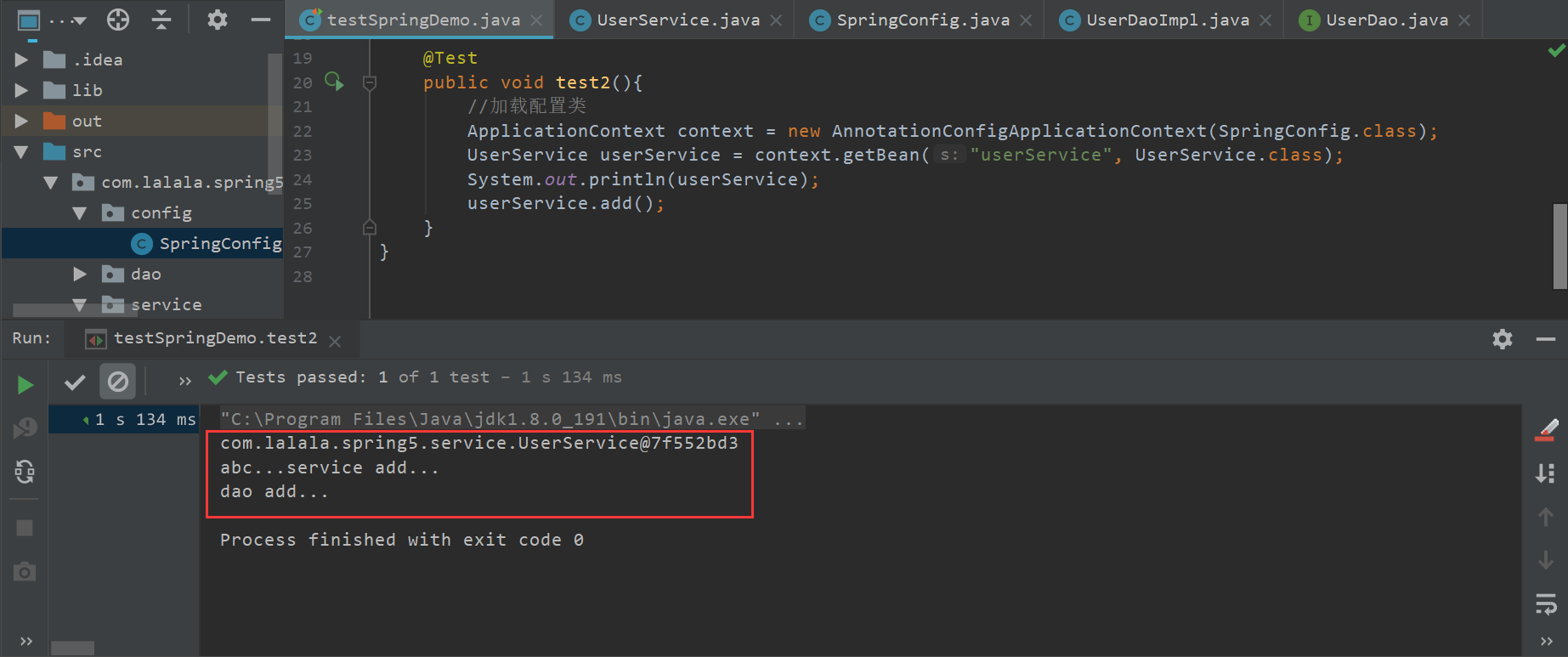Spring Bean管理
Spring的bean管理的两个操作:
-
Spring创建对象
-
Spring注入属性
Spring的bean管理两种实现方式
(1)基于xml配置文件方式实现
(2)基于注解方式实现
基于xml方式实现bean管理
基于xml方式创建对象的三种方式
方式1:使用默认构造函数创建,如果类中没有默认构造函数则无法创建
<!-- 配置User对象创建,使用默认构造函数的方式 -->
<bean id="user" class="com.lalala.spring5.User"></bean>
在 spring 配置文件中,使用 bean 标签,标签里面添加对应属性,就可以实现对象创建。
bean标签作用:
- 用于配置对象让spring来创建。
- 默认情况下它调用的是类中的无参构造函数。如果没有无参构造函数则不能创建成功。
bean标签的属性:
-
id:给对象在容器中提供一个唯一标识。用于获取对象。
-
class:指定类的全限定类名。用于反射创建对象。默认情况下调用无参构造函数。
-
scope:指定对象的作用范围。
- singleton: 默认值,单例的。
- prototype: 多例的。
- request: WEB项目中,Spring创建一个Bean的对象,将对象存入到request域中。
- session: WEB项目中,Spring创建一个Bean的对象,将对象存入到session域中。
- global session: WEB 项目中,应用在Portlet环境.如果没有Portlet环境那么globalSession相当于session。
-
init-method:指定类中的初始化方法名称。
-
destroy-method:指定类中销毁方法名称。
方式2:使用普通工厂中的方法创建对象
xml配置:
<bean id="instanceFactory" class="com.lalala.spring5.InstanceFactory"/>
<bean id="user" factory-bean="instanceFactory" factory-method="getUser"/>
工厂:
//模拟工厂类,该类我们无法通过修改源码来提供默认构造函数
public class InstanceFactory {
public User getUser(){
return new User();
}
}
方式3:使用静态工厂方法
xml配置
<!--使用工厂中的静态方法创建对象-->
<bean id="user" class="com.lalala.spring5.StaticFactory" factory-method="getUser"/>
静态工厂:
public class StaticFactory {
public static User getUser(){
System.out.println("static factory");
return new User();
}
}
基于xml方式注入属性
依赖注入(Dependency Injection,DI)就是注入属性,它是spring框架核心,是 ioc 的具体实现。就是注入属性
使用set方法注入属性
新建Book类:
package com.lalala.spring5;
public class Book {
private String bname;
private String bauthor;
public void setBname(String bname) {
this.bname = bname;
}
public void setBauthor(String bauthor) {
this.bauthor = bauthor;
}
public void testDemo(){
System.out.println(bname+":"+bauthor);
}
}
bean.xml配置文件如下
<?xml version="1.0" encoding="UTF-8"?>
<beans xmlns="http://www.springframework.org/schema/beans"
xmlns:xsi="http://www.w3.org/2001/XMLSchema-instance"
xsi:schemaLocation="http://www.springframework.org/schema/beans http://www.springframework.org/schema/beans/spring-beans.xsd">
<!--set方法注入属性-->
<bean id="book" class="com.lalala.spring5.Book">
<!--使用property完成属性注入
name:类里面属性名称
value:向属性注入的值
-->
<property name="bname" value="java入门到精通"></property>
<property name="bauthor" value="啦啦啦"></property>
</bean>
</beans>
测试代码如下:
package com.lalala.spring5.testdemo;
import com.lalala.spring5.Book;
import com.lalala.spring5.User;
import org.junit.Test;
import org.springframework.beans.factory.BeanFactory;
import org.springframework.context.ApplicationContext;
import org.springframework.context.support.ClassPathXmlApplicationContext;
public class TestSpring {
@Test
public void testBook(){
//1.加载配置文件
ApplicationContext context =
new ClassPathXmlApplicationContext("bean.xml");
//2.获取配置创建的对象
Book book = context.getBean("book", Book.class);
System.out.println(book);
book.testDemo();
}
}
使用有参数构造进行注入
新建Orders类
/**
* 使用有参数构造注入
*/
public class Orders {
private String oname;
private String address;
public Orders(String oname, String address) {
this.oname = oname;
this.address = address;
}
public void ordersTest(){
System.out.println(oname+":"+address);
}
}
bean.xml配置文件如下
<?xml version="1.0" encoding="UTF-8"?>
<beans xmlns="http://www.springframework.org/schema/beans"
xmlns:xsi="http://www.w3.org/2001/XMLSchema-instance"
xsi:schemaLocation="http://www.springframework.org/schema/beans http://www.springframework.org/schema/beans/spring-beans.xsd">
<!--有参数构造注入属性-->
<bean id="orders" class="com.lalala.spring5.Orders">
<constructor-arg name="oname" value="lalala"></constructor-arg>
<constructor-arg name="address" value="中国"></constructor-arg>
</bean>
</beans>
测试代码如下
package com.lalala.spring5.testdemo;
import com.lalala.spring5.Book;
import com.lalala.spring5.Orders;
import com.lalala.spring5.User;
import org.junit.Test;
import org.springframework.beans.factory.BeanFactory;
import org.springframework.context.ApplicationContext;
import org.springframework.context.support.ClassPathXmlApplicationContext;
public class TestSpring {
@Test
public void testOrders(){
//1.加载配置文件
ApplicationContext context =
new ClassPathXmlApplicationContext("bean.xml");
//2.获取配置创建的对象
Orders orders = context.getBean("orders", Orders.class);
System.out.println(orders);
orders.ordersTest();
}
}
p名称空间注入
使用p名称空间注入,可以简化基于xml配置方式
在配置文件中添加p名称空间:
<?xml version="1.0" encoding="UTF-8"?>
<beans xmlns="http://www.springframework.org/schema/beans"
xmlns:xsi="http://www.w3.org/2001/XMLSchema-instance"
xmlns:p="http://www.springframework.org/schema/p"
xsi:schemaLocation="http://www.springframework.org/schema/beans http://www.springframework.org/schema/beans/spring-beans.xsd">
<!--p名称空间注入-->
<bean id="book" class="com.lalala.spring5.Book" p:bname="python入门到精通" p:bauthor="略略略">
</bean>
</beans>
注入空值和特殊符号
空值注入方式:
<!--set方法注入属性-->
<bean id="book" class="com.lalala.spring5.Book">
<property name="bname" value="java入门到精通"></property>
<property name="bauthor" value="啦啦啦"></property>
<!--设置空值-->
<property name="address">
<null/>
</property>
</bean>
特殊符号注入方式:
<!--set方法注入属性-->
<bean id="book" class="com.lalala.spring5.Book">
<property name="bname" value="java入门到精通"></property>
<property name="bauthor" value="啦啦啦"></property>
<!--属性值包含特殊符号
1.可以把特殊符号进行转义
2.使用CDATA
-->
<property name="address">
<value><![CDATA[<<北京>>]]></value>
</property>
</bean>
注入外部bean
在dao和service包下新建对应的类:
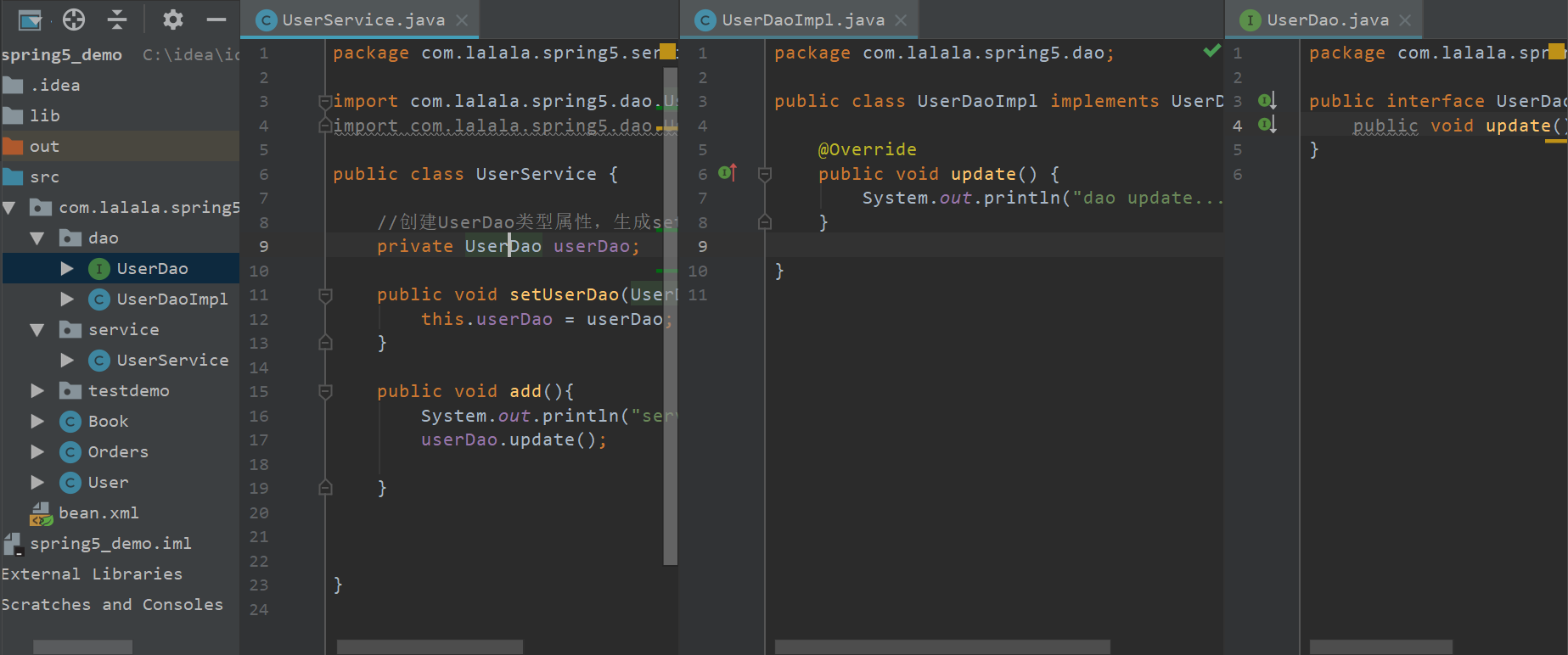
bean.xml配置如下:
<?xml version="1.0" encoding="UTF-8"?>
<beans xmlns="http://www.springframework.org/schema/beans"
xmlns:xsi="http://www.w3.org/2001/XMLSchema-instance"
xmlns:p="http://www.springframework.org/schema/p"
xsi:schemaLocation="http://www.springframework.org/schema/beans http://www.springframework.org/schema/beans/spring-beans.xsd">
<!--1. Service和Dao对象创建-->
<bean id="userService" class="com.lalala.spring5.service.UserService">
<!--注入userDao对象
name属性:类里面属性名称
ref属性:创建userDao对象bean标签id
-->
<property name="userDao" ref="userDaoImpl"></property>
</bean>
<bean id="userDaoImpl" class="com.lalala.spring5.dao.UserDaoImpl"></bean>
</beans>
注入内部bean和级联赋值
注入内部bean
新建Dept和Emp类:
//部门类
public class Dept {
private String dname;
public void setDname(String dname) {
this.dname = dname;
}
@Override
public String toString() {
return "Dept{" +
"dname='" + dname + '\'' +
'}';
}
}
//员工类
public class Emp {
private String ename;
private String gender;
private Dept dept;
public void setDept(Dept dept) {
this.dept = dept;
}
public Dept getDept() {
return dept;
}
public void setEname(String ename) {
this.ename = ename;
}
public void setGender(String gender) {
this.gender = gender;
}
public void add(){
System.out.println(ename+":"+gender+":"+dept);
}
}
bean.xml配置文件如下:
<?xml version="1.0" encoding="UTF-8"?>
<beans xmlns="http://www.springframework.org/schema/beans"
xmlns:xsi="http://www.w3.org/2001/XMLSchema-instance"
xmlns:p="http://www.springframework.org/schema/p"
xsi:schemaLocation="http://www.springframework.org/schema/beans http://www.springframework.org/schema/beans/spring-beans.xsd">
<!--内部bean-->
<bean id="emp" class="com.lalala.spring5.bean.Emp">
<property name="ename" value="lalala"></property>
<property name="gender" value="男"></property>
<!--设置对象类型属性-->
<property name="dept">
<bean id="dept" class="com.lalala.spring5.bean.Dept">
<property name="dname" value="保安部"></property>
</bean>
</property>
</bean>
</beans>
测试代码和输出:
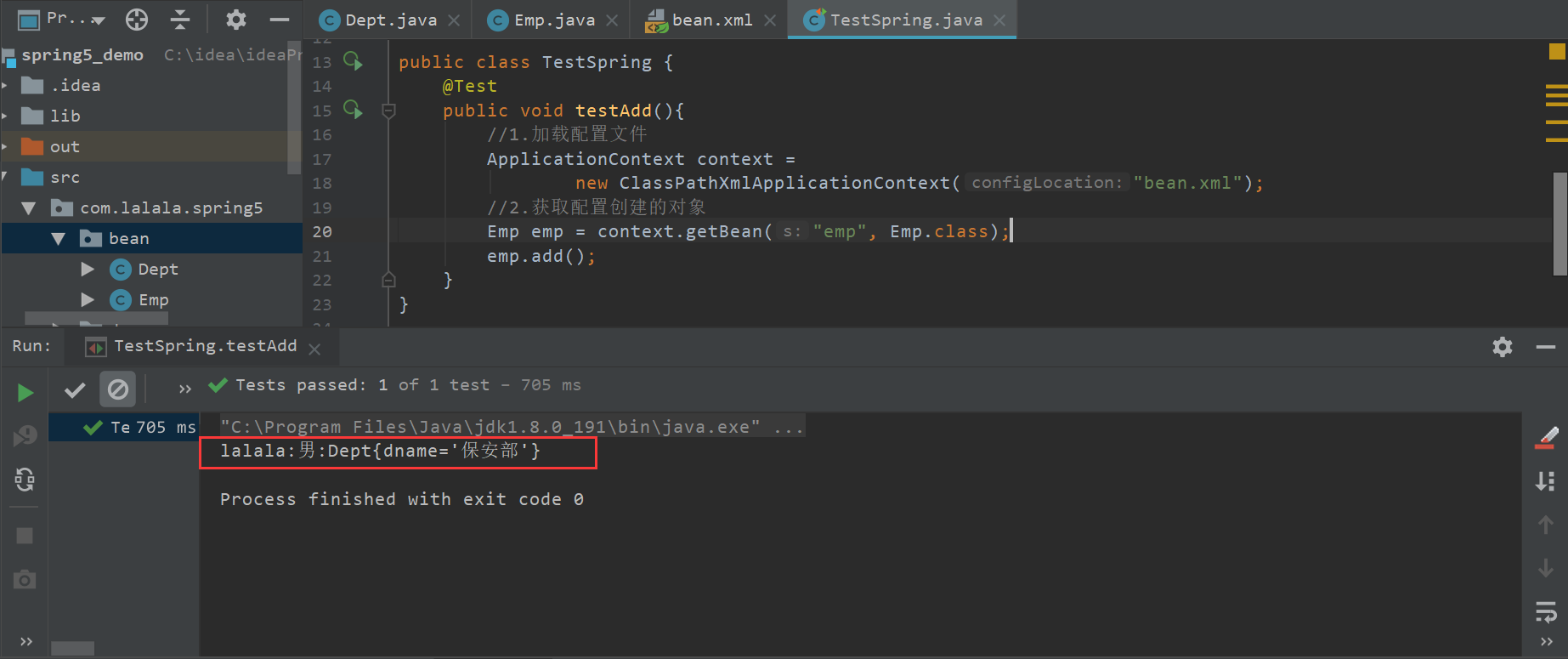
级联赋值
第一种写法:
<?xml version="1.0" encoding="UTF-8"?>
<beans xmlns="http://www.springframework.org/schema/beans"
xmlns:xsi="http://www.w3.org/2001/XMLSchema-instance"
xmlns:p="http://www.springframework.org/schema/p"
xsi:schemaLocation="http://www.springframework.org/schema/beans http://www.springframework.org/schema/beans/spring-beans.xsd">
<bean id="emp" class="com.lalala.spring5.bean.Emp">
<property name="ename" value="lalala"></property>
<property name="gender" value="男"></property>
<!--级联赋值-->
<property name="dept" ref="dept"></property>
</bean>
<bean id="dept" class="com.lalala.spring5.bean.Dept">
<property name="dname" value="财务部"></property>
</bean>
</beans>
第二种写法:
在Emp类中需要生成dept的get方法

配置文件bean.xml如下
<?xml version="1.0" encoding="UTF-8"?>
<beans xmlns="http://www.springframework.org/schema/beans"
xmlns:xsi="http://www.w3.org/2001/XMLSchema-instance"
xmlns:p="http://www.springframework.org/schema/p"
xsi:schemaLocation="http://www.springframework.org/schema/beans http://www.springframework.org/schema/beans/spring-beans.xsd">
<bean id="emp" class="com.lalala.spring5.bean.Emp">
<property name="ename" value="lalala"></property>
<property name="gender" value="男"></property>
<!--级联赋值-->
<property name="dept" ref="dept"></property>
<property name="dept.dname" value="技术部"></property>
</bean>
<bean id="dept" class="com.lalala.spring5.bean.Dept">
</bean>
</beans>
测试代码和输出如下
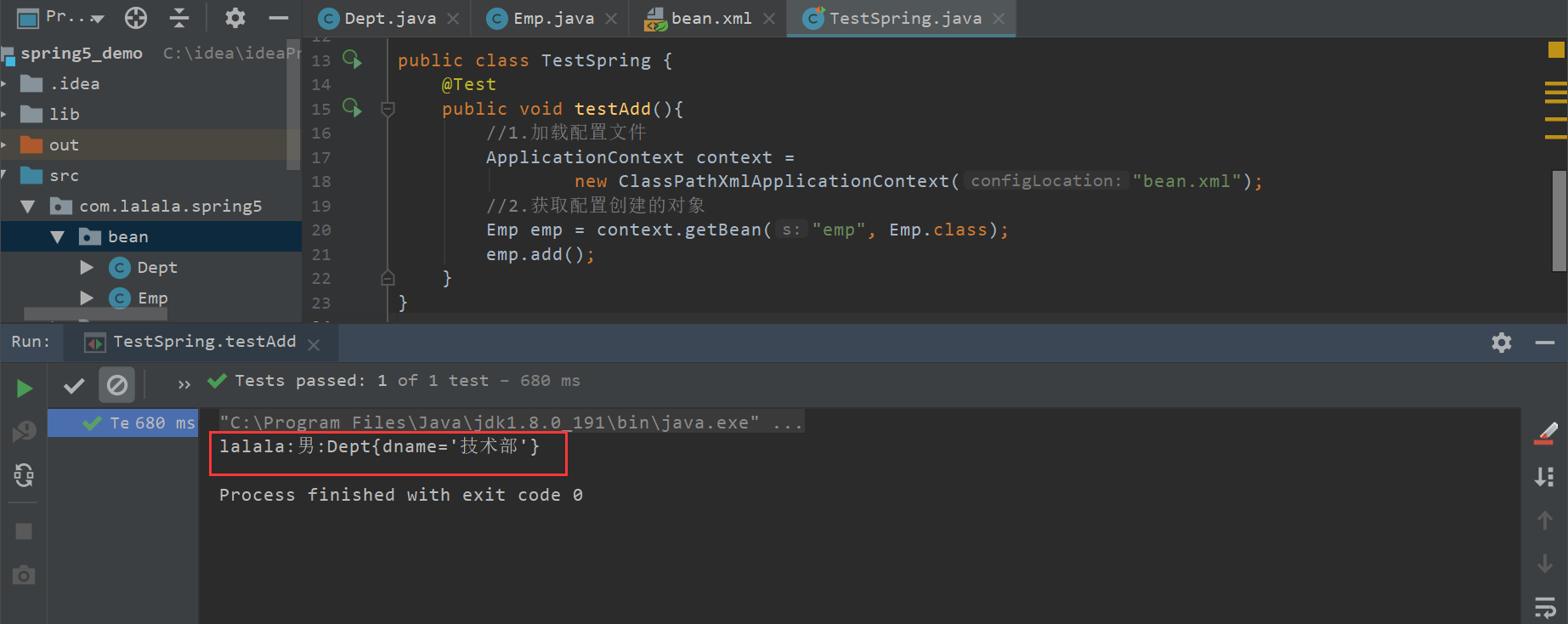
注入集合类型
新建Stu类,其中属性如下
package com.lalala.spring5;
import java.util.Arrays;
import java.util.List;
import java.util.Map;
import java.util.Set;
public class Stu {
//数组类型属性
private String[] courses;
//list集合类型属性
private List<String> list;
//map集合类型属性
private Map<String,String> maps;
//set集合类型属性
private Set<String> sets;
public void setCourses(String[] courses) {
this.courses = courses;
}
public void setList(List<String> list) {
this.list = list;
}
public void setMaps(Map<String, String> maps) {
this.maps = maps;
}
public void setSets(Set<String> sets) {
this.sets = sets;
}
public void test(){
System.out.println(Arrays.toString(courses));
System.out.println(list);
System.out.println(maps);
System.out.println(sets);
}
}
bean.xml配置文件如下
<?xml version="1.0" encoding="UTF-8"?>
<beans xmlns="http://www.springframework.org/schema/beans"
xmlns:xsi="http://www.w3.org/2001/XMLSchema-instance"
xmlns:p="http://www.springframework.org/schema/p"
xsi:schemaLocation="http://www.springframework.org/schema/beans http://www.springframework.org/schema/beans/spring-beans.xsd">
<bean id="stu" class="com.lalala.spring5.Stu">
<!--数组类型属性注入-->
<property name="courses">
<array>
<value>Java课程</value>
<value>数据库课程</value>
</array>
</property>
<!--list类型属性注入-->
<property name="list">
<list>
<value>张三</value>
<value>李四</value>
</list>
</property>
<!--map类型属性注入-->
<property name="maps">
<map>
<entry key="JAVA" value="java"></entry>
<entry key="PYTHON" value="python"></entry>
</map>
</property>
<!--set类型属性注入-->
<property name="sets">
<set>
<value>MySql</value>
<value>Redis</value>
</set>
</property>
</bean>
</beans>
集合注入对象值
新建Course类
package com.lalala.spring5;
public class Course {
private String cname; //课程名称
public void setCname(String cname) {
this.cname = cname;
}
@Override
public String toString() {
return "Course{" +
"cname='" + cname + '\'' +
'}';
}
}
Stu添加集合Course
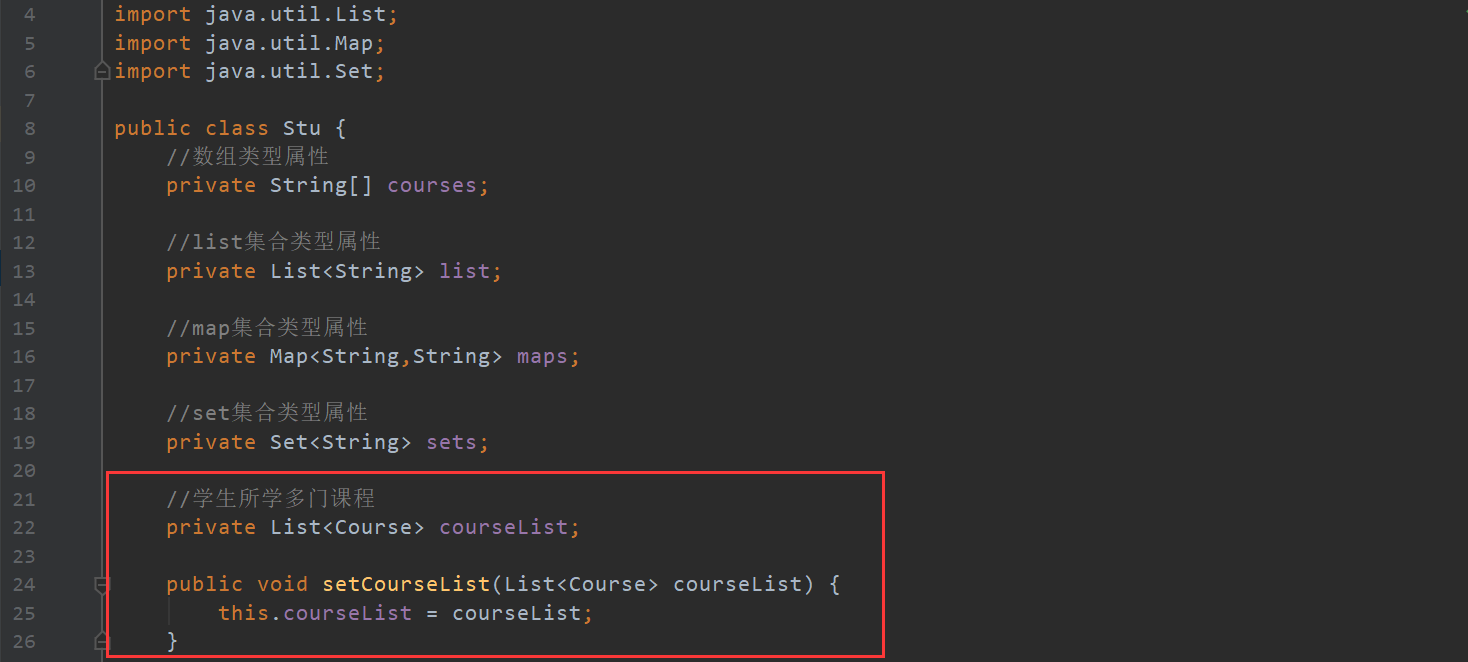
bean.xml配置文件如下
<?xml version="1.0" encoding="UTF-8"?>
<beans xmlns="http://www.springframework.org/schema/beans"
xmlns:xsi="http://www.w3.org/2001/XMLSchema-instance"
xmlns:p="http://www.springframework.org/schema/p"
xsi:schemaLocation="http://www.springframework.org/schema/beans http://www.springframework.org/schema/beans/spring-beans.xsd">
<!--1 集合类型属性注入-->
<bean id="stu" class="com.lalala.spring5.Stu">
<!--数组类型属性注入-->
<property name="courses">
<array>
<value>java课程</value>
<value>数据库课程</value>
</array>
</property>
<!--list类型属性注入-->
<property name="list">
<list>
<value>张三</value>
<value>小三</value>
</list>
</property>
<!--map类型属性注入-->
<property name="maps">
<map>
<entry key="JAVA" value="java"></entry>
<entry key="PHP" value="php"></entry>
</map>
</property>
<!--set类型属性注入-->
<property name="sets">
<set>
<value>MySQL</value>
<value>Redis</value>
</set>
</property>
<!--注入list集合类型,值是对象-->
<property name="courseList">
<list>
<ref bean="course1"></ref>
<ref bean="course2"></ref>
</list>
</property>
</bean>
<!--创建多个course对象-->
<bean id="course1" class="com.lalala.spring5.Course">
<property name="cname" value="Spring5框架"></property>
</bean>
<bean id="course2" class="com.lalala.spring5.Course">
<property name="cname" value="MyBatis框架"></property>
</bean>
</beans>
提取集合注入
新建Book类:
package com.lalala.spring5;
import java.util.List;
public class Book {
private List<String> list;
public void setList(List<String> list) {
this.list = list;
}
public void test(){
System.out.println(list);
}
}
在配置文件中引入名称空间util:
<?xml version="1.0" encoding="UTF-8"?>
<beans xmlns="http://www.springframework.org/schema/beans"
xmlns:xsi="http://www.w3.org/2001/XMLSchema-instance"
xmlns:p="http://www.springframework.org/schema/p"
xmlns:util="http://www.springframework.org/schema/util"
xsi:schemaLocation="http://www.springframework.org/schema/beans http://www.springframework.org/schema/beans/spring-beans.xsd
http://www.springframework.org/schema/util http://www.springframework.org/schema/util/spring-util.xsd">
<!--1 提取list集合类型属性注入-->
<util:list id="bookList">
<value>java入门</value>
<value>pyhton入门</value>
<value>mysql入门</value>
</util:list>
<!--2 提取list集合类型属性注入使用-->
<bean id="book" class="com.lalala.spring5.Book" scope="prototype">
<property name="list" ref="bookList"></property>
</bean>
</beans>
FactoryBean
1、Spring 有两种类型 bean,一种普通 bean,另外一种工厂bean(FactoryBean)。
2、普通 bean:在配置文件中定义 bean 类型就是返回类型。
3、工厂 bean:在配置文件定义 bean 类型可以和返回类型不一样。
新建MyBean类:
package com.lalala.spring5.factorybean;
import com.lalala.spring5.Course;
import org.springframework.beans.factory.FactoryBean;
//第一步 创建类,让这个类作为工厂 bean,实现接口 FactoryBean
//第二步 实现接口里面的方法,在实现的方法中定义返回的 bean 类型
public class MyBean implements FactoryBean<Course> {
@Override
public Course getObject() throws Exception {
Course course = new Course();
course.setCname("abc");
return course;
}
@Override
public Class<?> getObjectType() {
return null;
}
@Override
public boolean isSingleton() {
return false;
}
}
配置文件如下:
<?xml version="1.0" encoding="UTF-8"?>
<beans xmlns="http://www.springframework.org/schema/beans"
xmlns:xsi="http://www.w3.org/2001/XMLSchema-instance"
xmlns:p="http://www.springframework.org/schema/p"
xmlns:util="http://www.springframework.org/schema/util"
xsi:schemaLocation="http://www.springframework.org/schema/beans http://www.springframework.org/schema/beans/spring-beans.xsd
http://www.springframework.org/schema/util http://www.springframework.org/schema/util/spring-util.xsd">
<bean id="myBean" class="com.lalala.spring5.factorybean.MyBean">
</bean>
</beans>
测试代码和输出如下
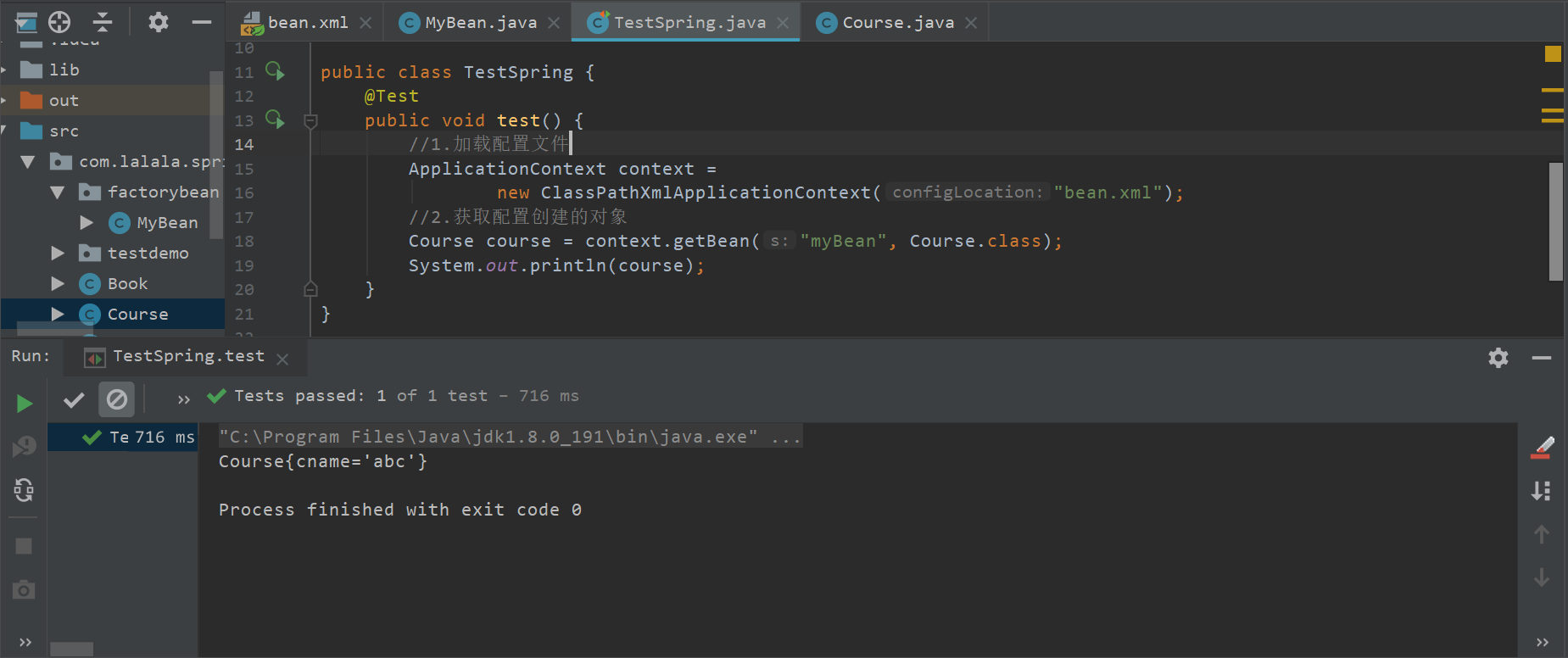
bean的作用域
在Spring中,默认情况下,bean是单实例对象。
在spring配置文件bean标签里面有属性(scope)用于设置单实例还是多实例。
-
scope="singleton":单实例对象,加载spring配置文件时候就会创建单实例对象。
-
scope="prototype":多实例对象,不是在加载spring配置文件时候创建对象,在调用getBean方法时候创建多实例对象。
<?xml version="1.0" encoding="UTF-8"?>
<beans xmlns="http://www.springframework.org/schema/beans"
xmlns:xsi="http://www.w3.org/2001/XMLSchema-instance"
xmlns:p="http://www.springframework.org/schema/p"
xmlns:util="http://www.springframework.org/schema/util"
xsi:schemaLocation="http://www.springframework.org/schema/beans http://www.springframework.org/schema/beans/spring-beans.xsd
http://www.springframework.org/schema/util http://www.springframework.org/schema/util/spring-util.xsd">
<bean id="book" class="com.lalala.spring5.Book" scope="prototype">
</bean>
</beans>
测试代码和输出如下:
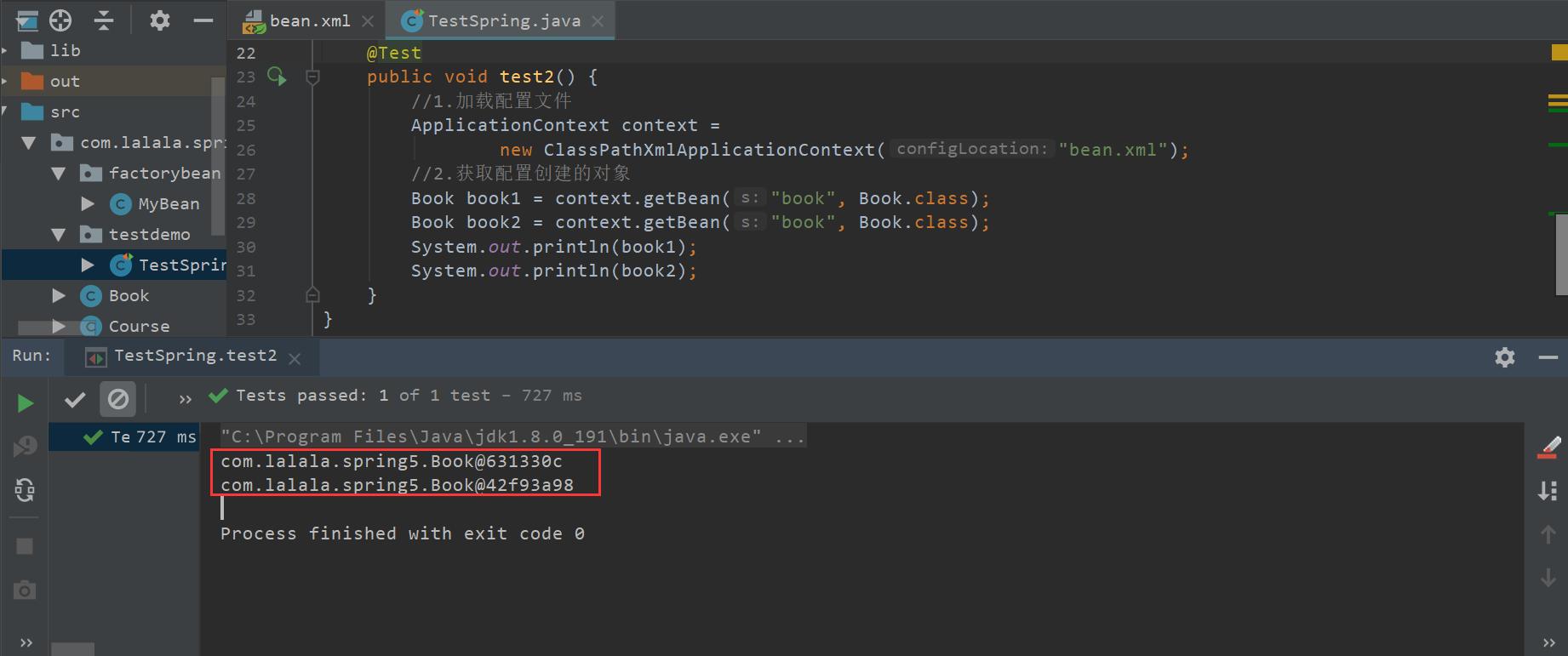
bean的生命周期
从对象创建到对象销毁的过程。
(1)通过构造器创建 bean 实例(无参数构造)
(2)为 bean 的属性设置值和对其他 bean 引用(调用 set 方法)
(3)调用 bean 的初始化的方法(需要进行配置初始化的方法)
(4)bean 可以使用了(对象获取到了)
(5)当容器关闭时候,调用 bean 的销毁的方法(需要进行配置销毁的方法)
新建Orders类:
package com.lalala.spring5.bean;
public class Orders {
private String oname;
//无参构造
public Orders() {
System.out.println("第一步 执行无参构造创建bean实例");
}
public void setOname(String oname) {
this.oname = oname;
System.out.println("第二步 调用set方法设置属性值");
}
//创建执行的初始化的方法
public void initMethod(){
System.out.println("第三步 执行初始化方法");
}
//创建执行的销毁的方法
public void destroyedMethod(){
System.out.println("第五步 执行销毁的方法");
}
}
配置文件如下:
<?xml version="1.0" encoding="UTF-8"?>
<beans xmlns="http://www.springframework.org/schema/beans"
xmlns:xsi="http://www.w3.org/2001/XMLSchema-instance"
xmlns:p="http://www.springframework.org/schema/p"
xmlns:util="http://www.springframework.org/schema/util"
xsi:schemaLocation="http://www.springframework.org/schema/beans http://www.springframework.org/schema/beans/spring-beans.xsd
http://www.springframework.org/schema/util http://www.springframework.org/schema/util/spring-util.xsd">
<bean id="orders" class="com.lalala.spring5.bean.Orders" init-method="initMethod" destroy-method="destroyedMethod">
<property name="oname" value="手机"></property>
</bean>
</beans>
测试代码和输出如下:
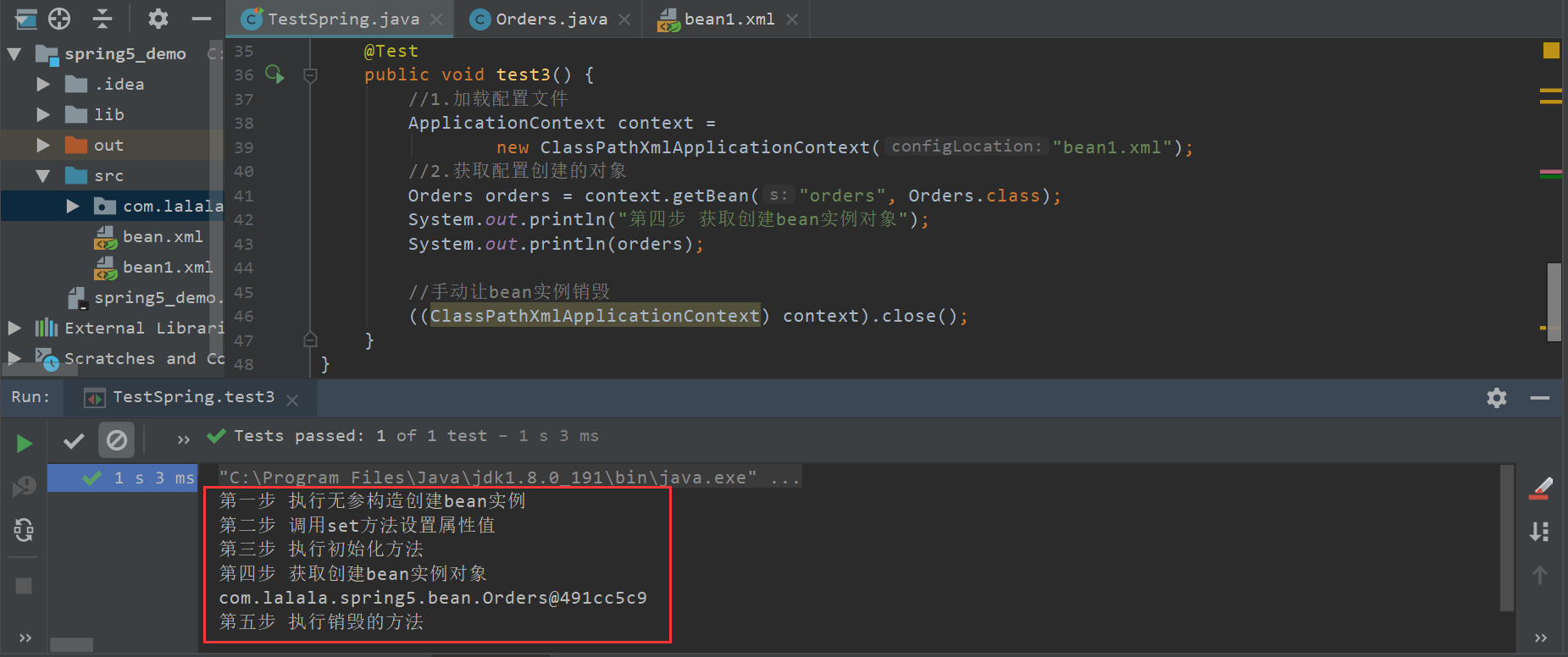
bean的后置处理器
bean生命周期有七步:
(1)通过构造器创建 bean 实例(无参数构造)
(2)为bean的属性设置值和对其他bean引用(调用 set 方法)
(3)把bean实例传递bean后置处理器的方法 postProcessBeforeInitialization
(4)调用bean的初始化的方法(需要进行配置初始化的方法)
(5)把 bean 实例传递 bean 后置处理器的方法 postProcessAfterInitialization
(6)bean可以使用了(对象获取到了)
(7)当容器关闭时候,调用 bean 的销毁的方法(需要进行配置销毁的方法)
演示添加后置处理器效果
创建类,实现接口BeanPostProcessor,创建后置处理器:
package com.lalala.spring5.bean;
import org.springframework.beans.BeansException;
import org.springframework.beans.factory.config.BeanPostProcessor;
public class MyBeanPost implements BeanPostProcessor {
@Override
public Object postProcessBeforeInitialization(Object bean, String beanName) throws BeansException {
System.out.println("在初始化之前执行的方法");
return bean;
}
@Override
public Object postProcessAfterInitialization(Object bean, String beanName) throws BeansException {
System.out.println("在初始化之后执行的方法");
return bean;
}
}
配置文件添加后置处理器:
<?xml version="1.0" encoding="UTF-8"?>
<beans xmlns="http://www.springframework.org/schema/beans"
xmlns:xsi="http://www.w3.org/2001/XMLSchema-instance"
xmlns:p="http://www.springframework.org/schema/p"
xmlns:util="http://www.springframework.org/schema/util"
xsi:schemaLocation="http://www.springframework.org/schema/beans http://www.springframework.org/schema/beans/spring-beans.xsd
http://www.springframework.org/schema/util http://www.springframework.org/schema/util/spring-util.xsd">
<bean id="orders" class="com.lalala.spring5.bean.Orders" init-method="initMethod" destroy-method="destroyedMethod">
<property name="oname" value="手机"></property>
</bean>
<!--配置后置处理器-->
<bean id="myBeanPost" class="com.lalala.spring5.bean.MyBeanPost"></bean>
</beans>
测试代码和输出如下:
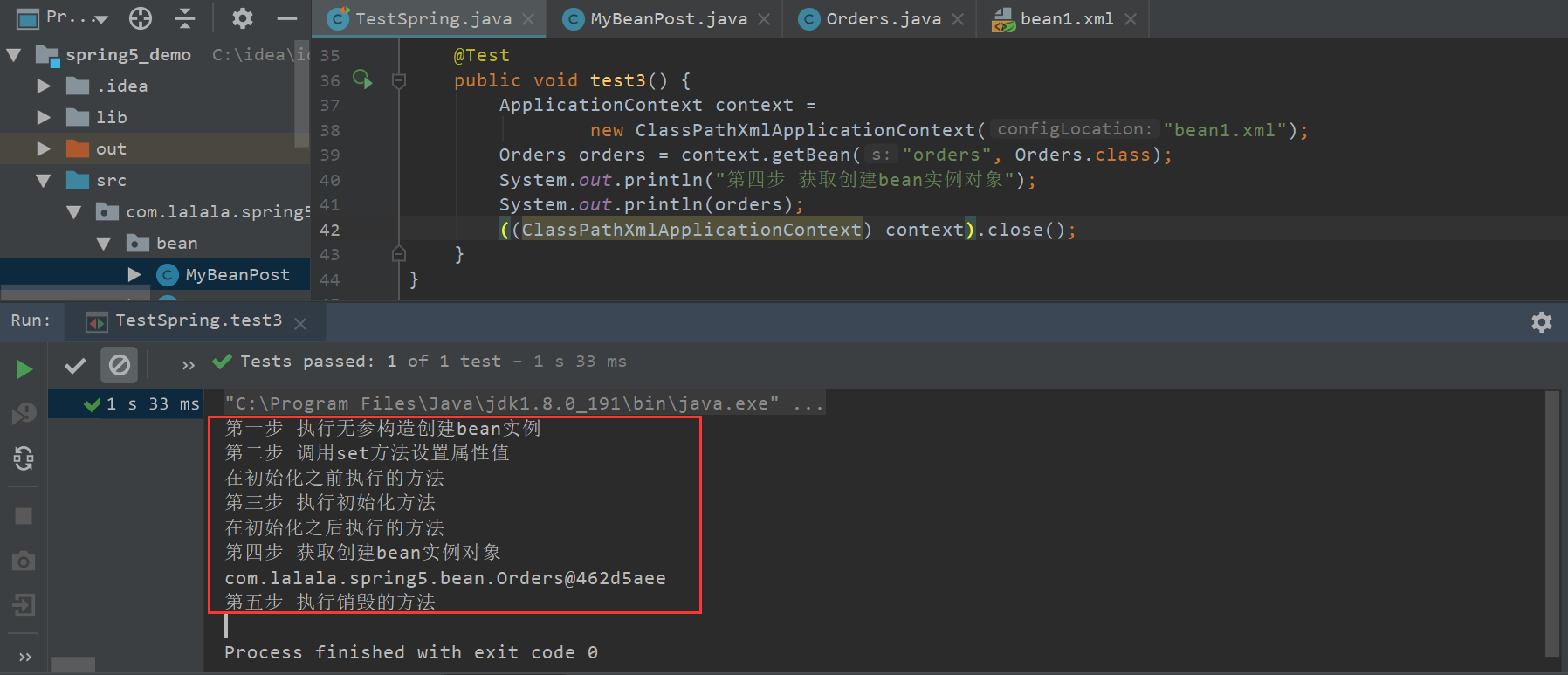
自动装配
自动装配:根据指定装配规则(属性名称或者属性类型),Spring自动将匹配的属性值进行注入。
新建Emp和Dept类:
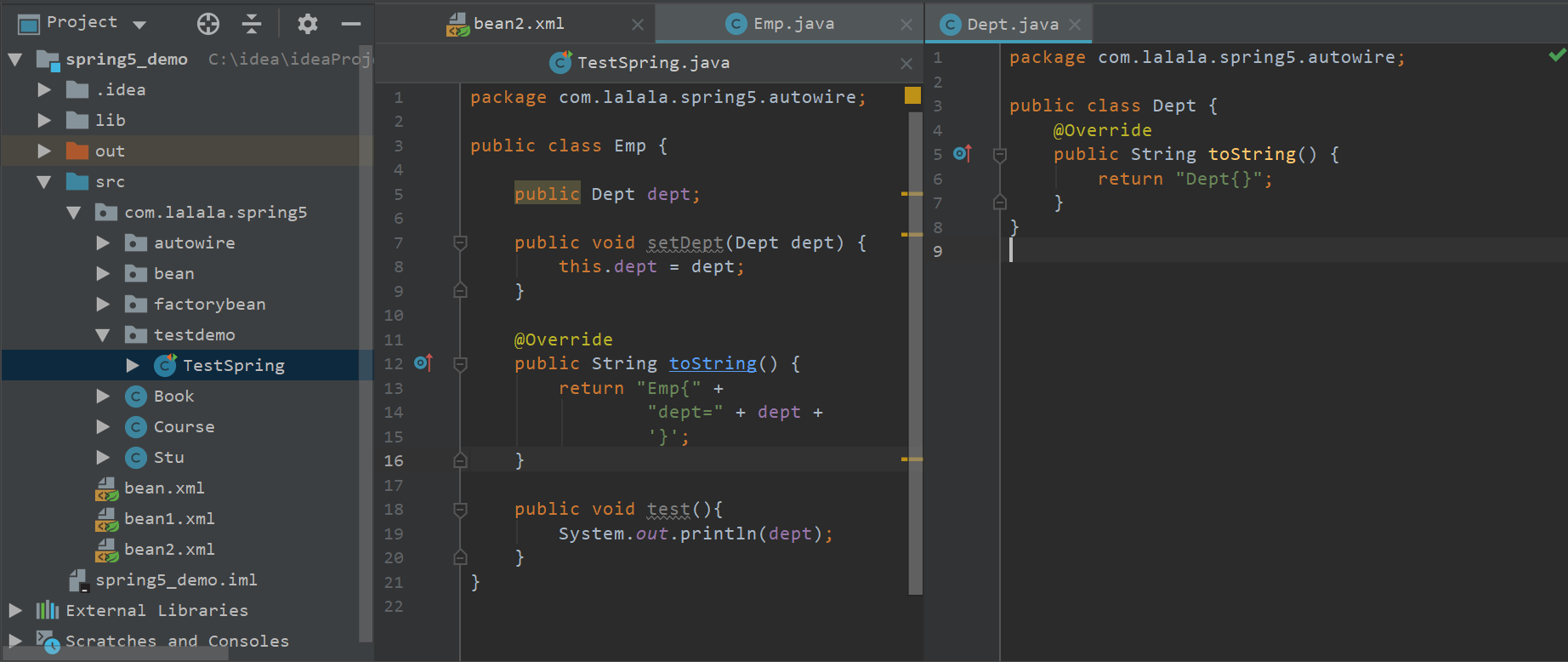
配置文件如下:
<?xml version="1.0" encoding="UTF-8"?>
<beans xmlns="http://www.springframework.org/schema/beans"
xmlns:xsi="http://www.w3.org/2001/XMLSchema-instance"
xmlns:p="http://www.springframework.org/schema/p"
xmlns:util="http://www.springframework.org/schema/util"
xsi:schemaLocation="http://www.springframework.org/schema/beans http://www.springframework.org/schema/beans/spring-beans.xsd
http://www.springframework.org/schema/util http://www.springframework.org/schema/util/spring-util.xsd">
<!--实现自动装配
bean标签属性autowire,配置自动装入
autowire属性常用两个值:
byName:根据属性名称注入,注入值bean的id值和类属性名称一样
byType:根据属性类型注入
-->
<bean id="emp" class="com.lalala.spring5.autowire.Emp" autowire="byName">
<!--<property name="dept" ref="dept"></property>-->
</bean>
<bean id="dept" class="com.lalala.spring5.autowire.Dept"></bean>
</beans>
测试代码和输出如下:
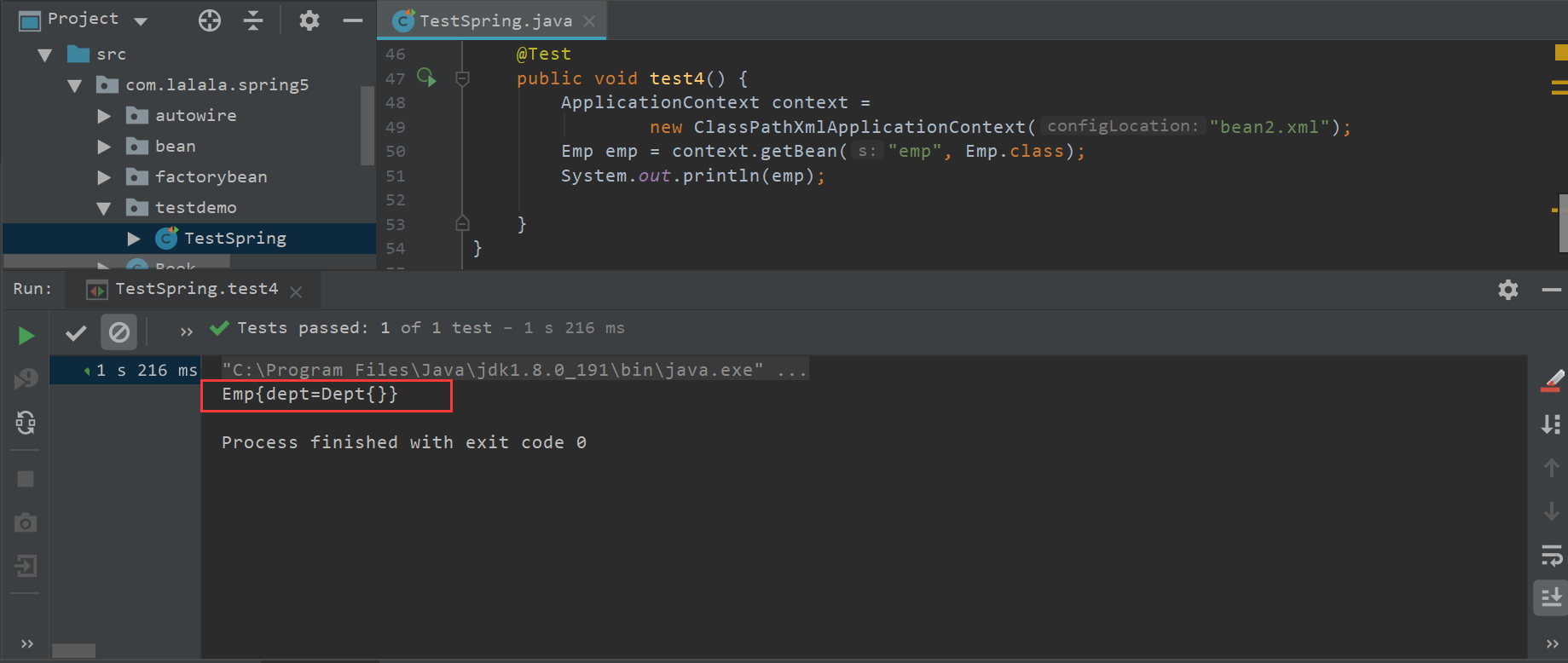
外部属性文件
1、直接配置数据库信息
(1)引入druid的jar包
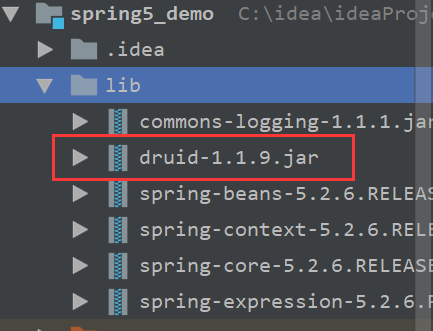
(2)配置druid连接池
<?xml version="1.0" encoding="UTF-8"?>
<beans xmlns="http://www.springframework.org/schema/beans"
xmlns:xsi="http://www.w3.org/2001/XMLSchema-instance"
xmlns:p="http://www.springframework.org/schema/p"
xmlns:util="http://www.springframework.org/schema/util"
xsi:schemaLocation="http://www.springframework.org/schema/beans http://www.springframework.org/schema/beans/spring-beans.xsd
http://www.springframework.org/schema/util http://www.springframework.org/schema/util/spring-util.xsd">
<!--直接配置连接池-->
<bean id="dataSource" class="com.alibaba.druid.pool.DruidDataSource">
<property name="driverClassName" value="com.mysql.jdbc.Driver"></property>
<property name="url" value="jdbc:mysql://localhost:3306/userDb"></property>
<property name="username" value="root"></property>
<property name="password" value="123456"></property>
</bean>
</beans>
2、引入外部属性文件配置数据库连接池
(1)创建外部属性文件,properties格式文件,写数据库信息
名称为jdbc.properties
prop.driverClass=com.mysql.jdbc.Driver
prop.url=jdbc:mysql://localhost:3306/userDb
prop.userName=root
prop.password=123456
(2)把外部properties属性文件引入到spring配置文件中
引入context名称空间
<?xml version="1.0" encoding="UTF-8"?>
<beans xmlns="http://www.springframework.org/schema/beans"
xmlns:xsi="http://www.w3.org/2001/XMLSchema-instance"
xmlns:p="http://www.springframework.org/schema/p"
xmlns:util="http://www.springframework.org/schema/util"
xmlns:context="http://www.springframework.org/schema/context"
xsi:schemaLocation="http://www.springframework.org/schema/beans http://www.springframework.org/schema/beans/spring-beans.xsd
http://www.springframework.org/schema/util http://www.springframework.org/schema/util/spring-util.xsd
http://www.springframework.org/schema/context http://www.springframework.org/schema/context/spring-context.xsd">
<!--引入外部属性文件-->
<context:property-placeholder location="classpath:jdbc.properties"/>
<!--配置连接池-->
<bean id="dataSource" class="com.alibaba.druid.pool.DruidDataSource">
<property name="driverClassName" value="${prop.driverClass}"></property>
<property name="url" value="${prop.url}"></property>
<property name="username" value="${prop.userName}"></property>
<property name="password" value="${prop.password}"></property>
</bean>
</beans>
基于注解方式实现bean管理
基于注解方式创建对象
(1)@Component
(2)@Service
(3)@Controller
(4)@Repository
上面四个注解功能是一样的,都可以用来创建bean实例。
第一步 引入依赖
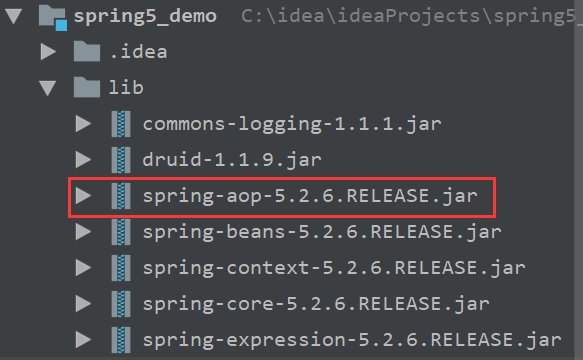
第二步 开启组件扫描
<?xml version="1.0" encoding="UTF-8"?>
<beans xmlns="http://www.springframework.org/schema/beans"
xmlns:xsi="http://www.w3.org/2001/XMLSchema-instance"
xmlns:context="http://www.springframework.org/schema/context"
xmlns:aop="http://www.springframework.org/schema/aop"
xsi:schemaLocation="http://www.springframework.org/schema/beans http://www.springframework.org/schema/beans/spring-beans.xsd
http://www.springframework.org/schema/context http://www.springframework.org/schema/context/spring-context.xsd
http://www.springframework.org/schema/aop http://www.springframework.org/schema/aop/spring-aop.xsd">
<!-- 开启注解扫描 -->
<context:component-scan base-package="com.lalala"></context:component-scan>
</beans>
第三步 创建类在上面添加注解
//value里面的值可以省略不写,
//默认值是类名称,首字母小写,UserService -- userService
@Component(value = "userService")
public class UserService {
public void add(){
System.out.println("service add...");
}
}
测试代码和输出如下
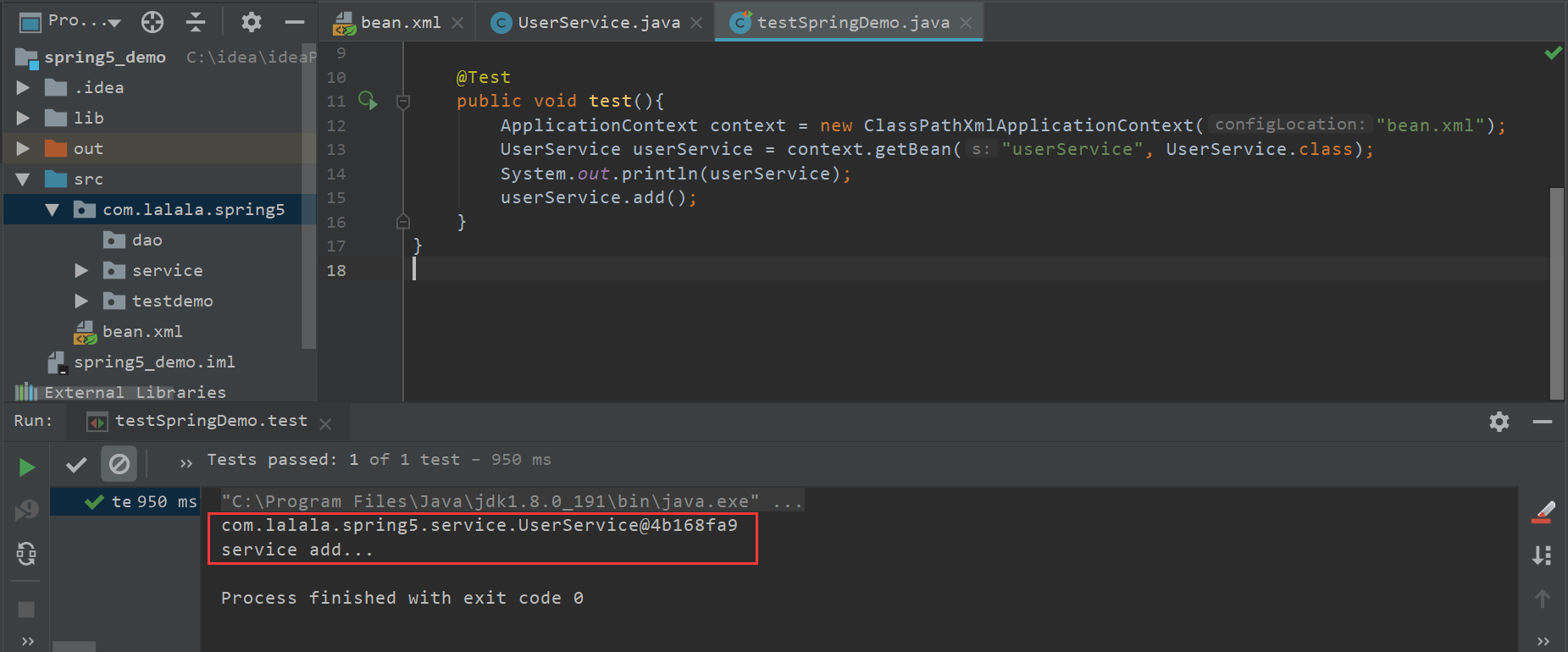
开启组件扫描配置细节
<!--示例 1
use-default-filters="false" 表示现在不使用默认 filter,自己配置 filter
context:include-filter ,设置扫描哪些内容
-->
<context:component-scan base-package="com.atguigu" use-defaultfilters="false">
<context:include-filter type="annotation" expression="org.springframework.stereotype.Controller"/>
</context:component-scan>
<!--示例 2
下面配置扫描包所有内容
context:exclude-filter: 设置哪些内容不进行扫描
-->
<context:component-scan base-package="com.atguigu">
<context:exclude-filter type="annotation"
expression="org.springframework.stereotype.Controller"/>
</context:component-scan>
基于注解方式注入属性
(1)@Autowired:根据属性类型进行自动装配
第一步,把service和dao对象创建,在service和dao类添加创建对象注解
第二步,在service注入dao对象,在service类添加dao类型属性,在属性上面使用注解
新建UserDao接口和实现类UserDaoImpl:
UserDaoImpl实现类需要添加注解,如下图所示
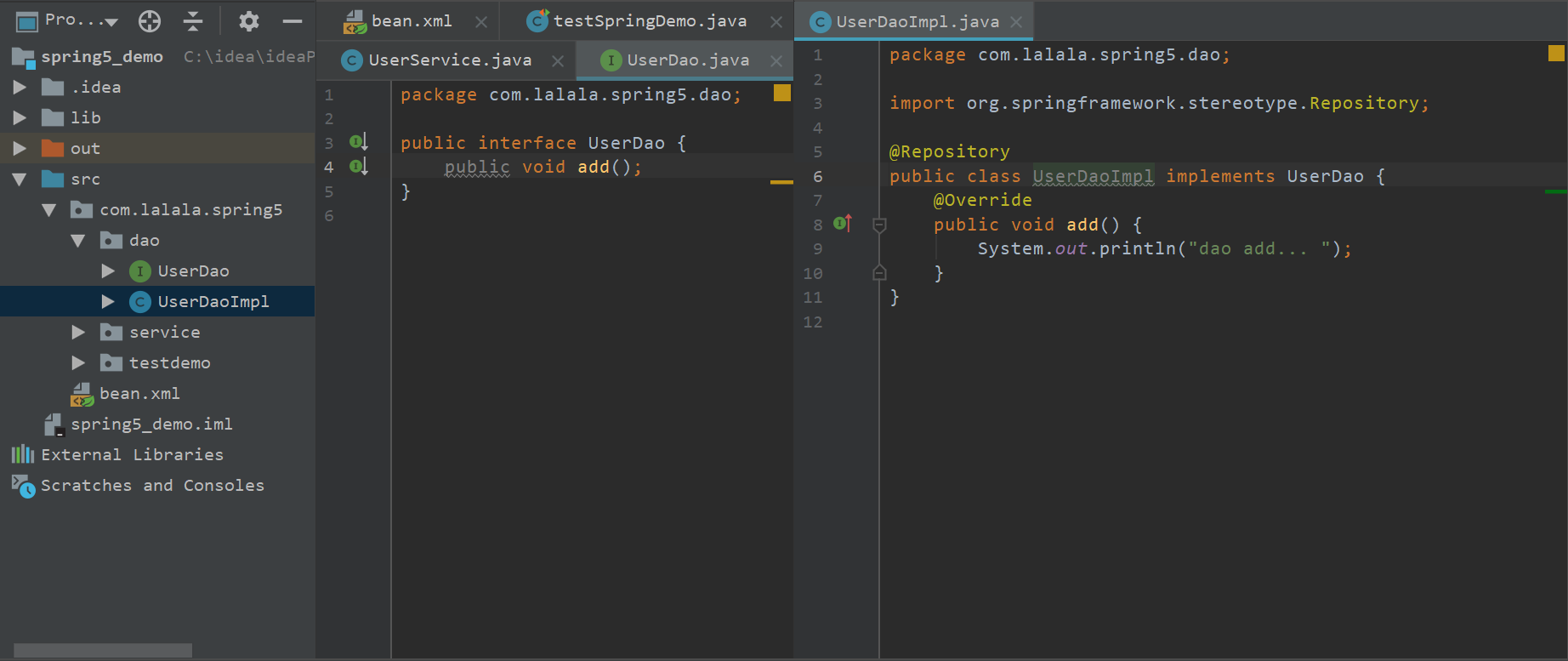
在UserService注入UserDao:
//value里面的值可以省略不写,
//默认值是类名称,首字母小写,UserService -- userService
//@Component(value = "userService")
@Service
public class UserService {
//添加注入属性注解
@Autowired
private UserDao userDao;
public void add(){
System.out.println("service add...");
userDao.add();
}
}
测试代码和运行结果如下:
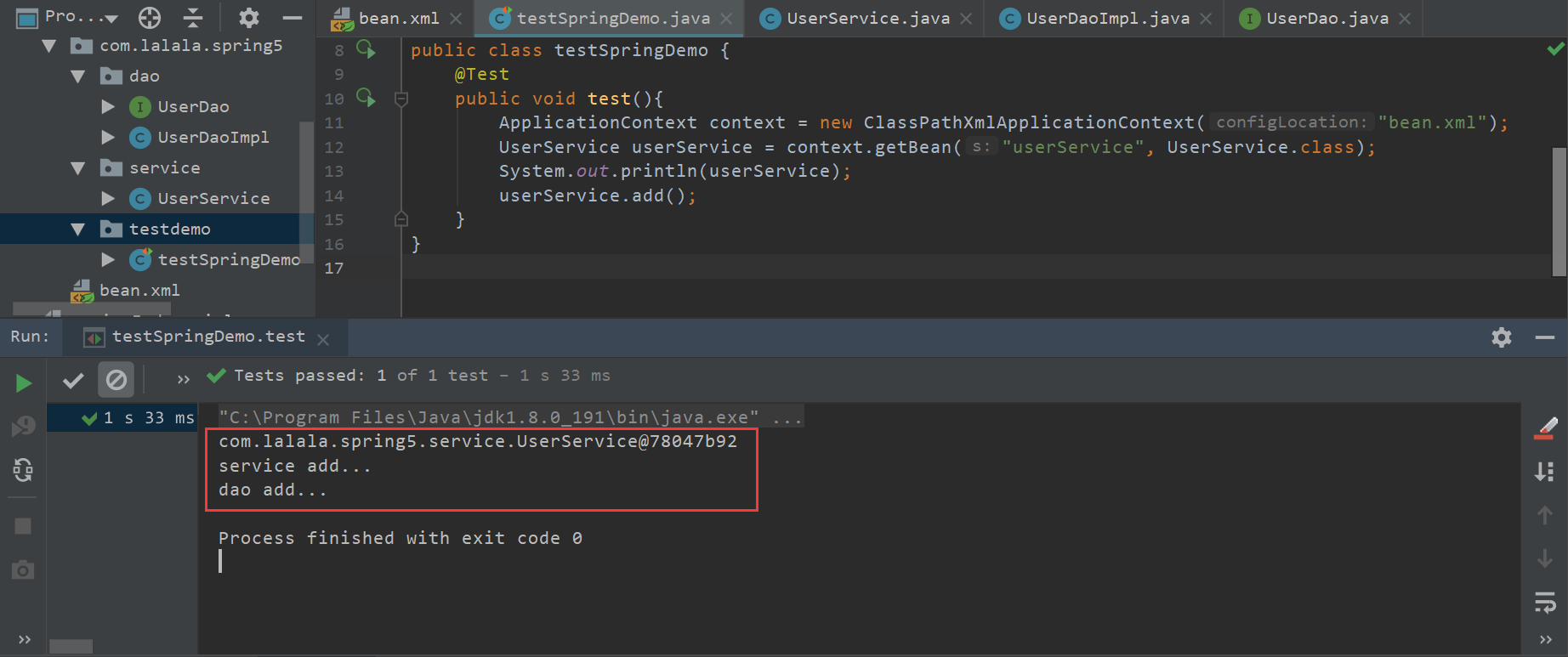
(2)@Qualifier:根据名称进行注入
这个@Qualifier注解需要和上面@Autowired一起使用
当一个接口有多个实现类时,可以使用这个注解
在UserDaoImpl上添加@Repository(value = "userDaoImpl1")
@Repository(value = "userDaoImpl1")
public class UserDaoImpl implements UserDao {
@Override
public void add() {
System.out.println("dao add... ");
}
}
UserService中使用@Qualifier(value = "userDaoImpl1")
//value里面的值可以省略不写,
//默认值是类名称,首字母小写,UserService -- userService
//@Component(value = "userService")
@Service
public class UserService {
//添加注入属性注解
@Autowired //根据类型进行注入
@Qualifier(value = "userDaoImpl1") //根据名称进行注入
private UserDao userDao;
public void add(){
System.out.println("service add...");
userDao.add();
}
}
测试代码同样输出如下内容
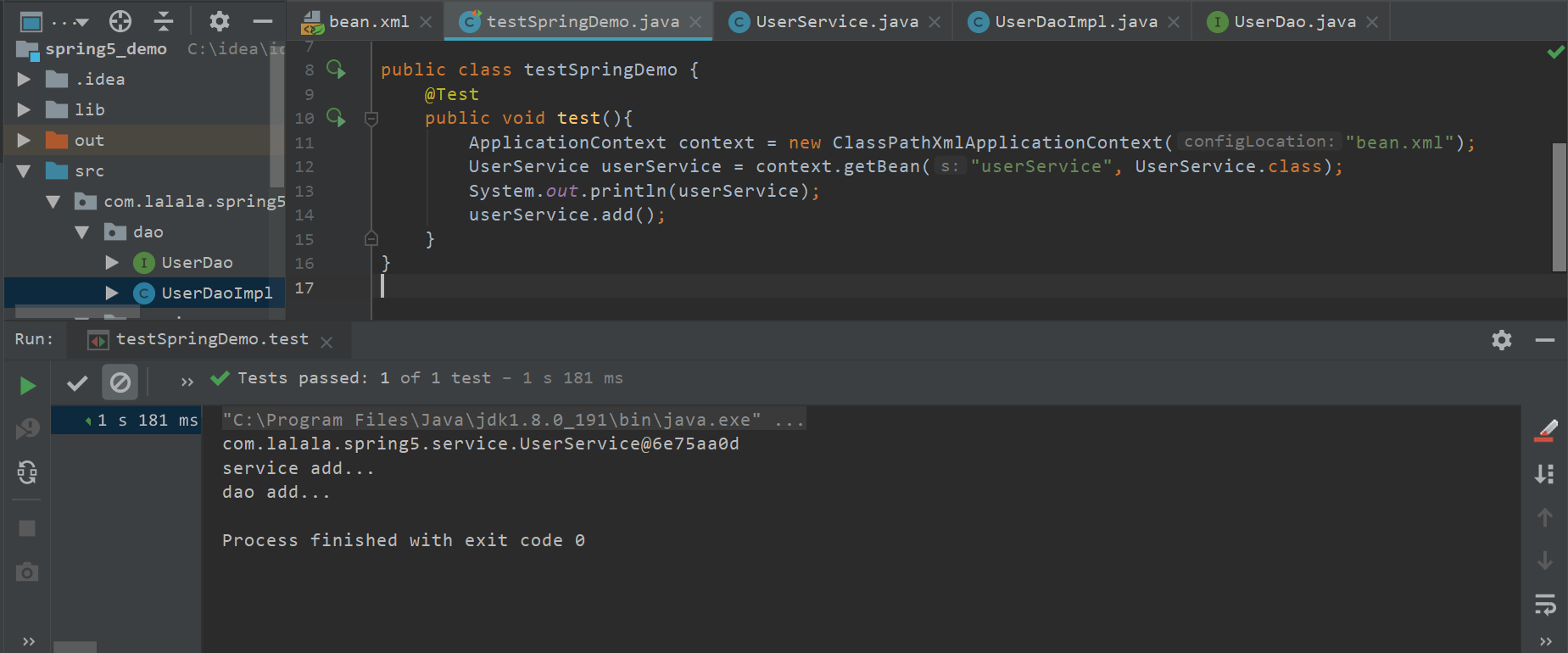
(3)@Resource:可以根据类型注入,可以根据名称注入
//value里面的值可以省略不写,
//默认值是类名称,首字母小写,UserService -- userService
//@Component(value = "userService")
@Service
public class UserService {
//@Resource //根据类型进行注入
@Resource(name = "userDaoImpl1") //根据名称进行注入
private UserDao userDao;
public void add(){
System.out.println("service add...");
userDao.add();
}
}
(4)@Value:注入普通类型属性
@Service
public class UserService {
@Value(value = "abc")
private String name;
//添加注入属性注解
//@Autowired //根据类型进行注入
//@Qualifier(value = "userDaoImpl1") //根据名称进行注入
//@Resource //根据类型进行注入
@Resource(name = "userDaoImpl1") //根据名称进行注入
private UserDao userDao;
public void add(){
System.out.println(name + "...service add...");
userDao.add();
}
}
常用注解
@Scope
@Scope指定bean的作用范围。
-
属性:
value:指定范围的值。
- 取值:singleton prototype request session globalsession
@Configuration
@Configuration用于定义配置类,可替换xml配置文件,被注解的类内部包含有一个或多个被@Bean注解的方法,这些方法将会被AnnotationConfigApplicationContext或AnnotationConfigWebApplicationContext类进行扫描,并用于构建bean定义,初始化Spring容器。一般用于注册非表现层、业务层、持久层的对象。
示例代码:
/**
* spring 的配置类,相当于 bean.xml 文件
*/
@Configuration
@ComponentScan("com.lalala")
public class SpringConfiguration {
}
@ComponentScan
用于指定 spring 在初始化容器时要扫描的包, 作用和在 spring 的 xml 配置文件指定是一样的。
<context:component-scan base-package="com.lalala"/>
@Bean
@Bean用于把当前方法的返回值(对象)作为Bean对象存入Spring的IoC容器中。该注解只能写在方法上。
-
属性:
name:给当前@Bean注解的方法创建的对象指定一个名称(即bean的id)。当不写时,默认值是当前方法的名称。
/**
* 连接数据库的配置类
*/
public class JdbcConfig {
/**
* 创建一个数据源,并存入 spring 容器中
* @return
*/
@Bean(name="dataSource")
public DataSource createDataSource() {
try {
ComboPooledDataSource ds = new ComboPooledDataSource();
ds.setUser("root");
ds.setPassword("1234");
ds.setDriverClass("com.mysql.jdbc.Driver");
ds.setJdbcUrl("jdbc:mysql:///spring_day02");
return ds;
} catch (Exception e) {
throw new RuntimeException(e);
}
}
}
@PropertySource
@PropertySource用于加载 .properties文件中的配置。例如我们配置数据源时,可以把连接数据库的信息写到properties配置文件中,就可以使用此注解指定 properties 配置文件的位置。
@Configuration
@ComponentScan(basePackages = "com.itlalala")
@PropertySource("classpath:jdbc.properties")
public class SpringConfiguration {
}
jdbc.properties
jdbc.driver=com.mysql.jdbc.Driver
jdbc.url=jdbc:mysql://localhost:3306/spring_test
jdbc.username=root
jdbc.password=1234
使用@Value就可以获取配置的值
@Value("${jdbc.driver}")
private String driver;
@Value("${jdbc.url}")
private String url;
@Value("${jdbc.username}")
private String username;
@Value("${jdbc.password}")
private String password;
完全注解开发
(1)创建配置类,替代xml配置文件
package com.lalala.spring5.config;
import org.springframework.context.annotation.ComponentScan;
import org.springframework.context.annotation.Configuration;
@Configuration //作为配置类,替代xml配置文件
@ComponentScan(basePackages = "com.lalala")
public class SpringConfig {
}
(2)编写测试类
public class testSpringDemo {
@Test
public void test2(){
//加载配置类
ApplicationContext context = new AnnotationConfigApplicationContext(SpringConfig.class);
UserService userService = context.getBean("userService", UserService.class);
System.out.println(userService);
userService.add();
}
}
测试代码和输出:
